A Compact 8877 50MHz Amplifier
and Power Supply
This is "Real" Amateur Radio
on the Internet!
 Main
Features include:
Main
Features include:
Mini Compact Units
Large Easy to read Meters
1.8 KvaToroidal Transformer
Slow Start Safety Circuit
Filament In-rush Protection
Strong Die-cast Chassis
Just 2 15kv 1.2Amp Rectifiers
Protection Timer
Switch/Circuit Breaker
Simple to Reproduce
Simple to Build
-60db Harmonics + 1/4 wave Stub
Full Internet Parts Listing
WARNING:
THIS PROJECT CONTAINS VERY HIGH VOLTAGES.
The reason for building this amplifier is to
conduct Ionoscatter/Troposcatter along with FAI tests, it has been good
fun, and, a good building exercise in producing an amplifier so compact
and clean, and which has been duplicated from these pages 5 times so far
(7/3/98).
It was decided to use an 8877 triode tube as the 3rd order IP's
are -41db compared to a pair of 3CX800's which are -36db. This offers the
best possible spectral signal.
UK amateurs are only allowed 26dbw (400w) of which tests so far
indicate only weak Troposcatter/Ionoscatter signals enhanced by Meteor
bursts/burns at the 1200 kms mark. A special permit has been issued for
this amplifier which permits 30dbw at the antenna feedpoint.
PSU AND RF DECK VIEWS.
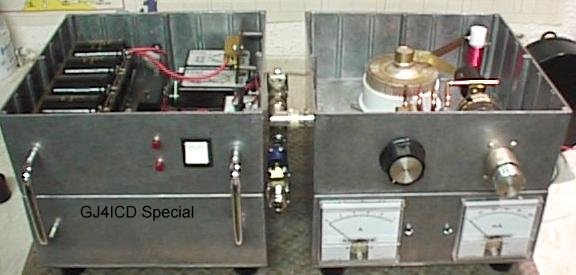
A chassis was needed and after careful consideration
it was decided to use the 3CX800A7 diecast metalwork box idea design on
our other Internet pages. Die-cast boxes are very strong, albeit a pain
to drill and work with, 2 Radiospares boxes were ordered from
here , (the xyl paid for these as a birthday present!) these were 10"
square and 4" high, they were mounted back to back (or bottom to bottom)
after cutting all but 1/2" out of one of the boxes (similar to the 3CX800
design). Above is both the PSU and the RF deck, note the RF relays
on the side of the RF deck, these could be fitted on to the rear of the
RF deck if preffered and then the 2 units could be bolted together side
by side, or, the units can be stacked on top of each other if required.
The meters are about 3 1/2" square and are available from RS Components,
no shunts are needed. All the metalwork was done with standard hand tools
and an electric drill, no special hole cutters were used due to the size
of the holes needed.
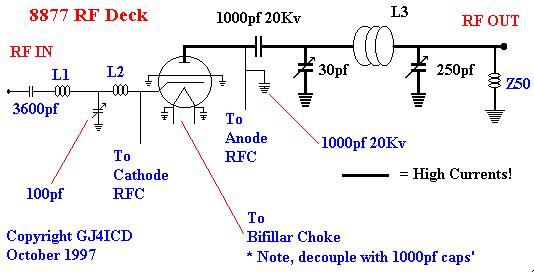 Here is the 8877 circuit.
Here is the 8877 circuit.
AMPLIFIER
PARTS LISTING
ANODE SECTION:
RS Die-cast Boxes # 225-271 (2 needed for RF deck)
N Socket RS # 223-9575 (Don't use SO/PL259 types!)
RFC2 (Anode Choke) 50t of 22swg on
3/4" PTFE Rod. ( winding is 1 3/4" long, rod length is 3 1/4" with tapped
hole in one end for support). You will have to make this choke.
The Z50 output choke is made from 1/4"
teflon/tufnol rod, 1 3/4" long, the winding is 1 7/16" long and is approx
66 turns of 28swg, this is connected across the output socket.
A Miller RFC50 can also be used here which is 68 turns of 32 swg
on a 1/4" tufnol rod, however, an even better approach is a 1/4 wave shorted
stub on the output connector, this has two functions, a) it will trip the
PSU if the blocking capacitor goes short, and b) it attenuates 100MHz by
over 30db. The stub length is around 40" but start with more before trimming,
and use good quality coax.
Anode tuning capacitor is a 30pf 15kv variable vacuum type CADD
30 15 found Here
Anode tuning coil is 3 turns 1 1/4" in diameter and about 3" long
made of 1/4" tubing.
Loading capacitor is 259pf widespaced CAV 75 37 found
Here
Eimac 8877 Tube plus Eimac matching socket and chimney available
Here or from
RF parts in the USA Here
(Socket # SK2210, Chimney # SK2216).
1000pf 20kv Erie Doorknob capacitors for the blocking and decoupling
of the EHT.
EHT Connector plug /skt from Surplus Sales Nebraska. (15kv Kit)
Here!
The EHT kit has both plug and socket plus lead and is coded Alden (CNE) 8101SET $14.
(note only one is needed).
CATHODE SECTION:
8877 Filament Transformer 5v 10 amp, 12v 1 amp from Surplus Sales
Nebraska Here!
or from Peter Dahl
Here
(Make sure that you order 110v or 220v AC).
12 Volt 50 or 75 watt Zener for Bias. ( Farnell
Components Ltd ) # BZY91C12
A small pcb fuse holder and tag board for the bias circuit, single
pole 12volt relay for the bias circuit available Here
Tag Boards for above are available from RS, part # 433-725 (pack
of 5)
A 2 amp bridge for the 13.5 volt supply with suitable electrolytic
capacitor found Here
A 10k 12 watt wirewound resistor that is shorted out on TX.
Farnell Components Ltd
A 220 ohm 12 watt wirewound resistor that shunts the cathode fuse
and Zener.
You can use 2 and 4 pin Mic plug/sockets for the LT/B- and earth
lines.
CATHODE RF SECTION: (This is a duplication
of the 3CX800 input circuit)
Input capacitor 3600pf silver mica 500v. (RS # 495-919)
L1 is 10 turns of 18 swg 5/8" in dia tinned copper wire:
L2 is 10 turns of 18 swg 5/8" in dia tinned copper wire: (both coils
are the same).
C1 is 100pf Jackson type capacitor C804: # FF48C (Maplin
Here ) or similar.
Cathode RFC (choke) 48 turns of 22swg enamelled on 1/4" tufnol former.
Heater choke (RFC). 15 turns of 16swg enamelled on 1/2" ferrite
rod. Note that this is a bifilar winding, in other words two lengths of
enamelled covered wire wound side by side on the 1/2" ferrite rod covered
with heatshrink first.
Meters are available from RS # 258-912 for the 1 amp anode meter
and # 258-906 for the 100 M/A Grid meter. They can also be obtained from
UK company CPC Ltd, Tel 01772 654455. 1 amp Meter is PM11122, 100
M/A Meter is PM11199, Back lights PM11191 2 packs.
The Bits!
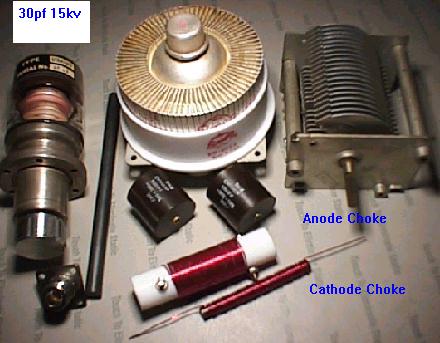 Above can be seen the 8877 plus loading capacitor, also the "space
wound" cathode choke along with the main anode RF choke wound on PTFE stock.
Above can be seen the 8877 plus loading capacitor, also the "space
wound" cathode choke along with the main anode RF choke wound on PTFE stock.
The capacitor on the left is a 30pf Variable Vac' type at 15kv,
the two capacitors in front of the tube are 1000pf 20kv doorknobs, one
is used as the "blocking" capacitor from the tube to the tuned circuit,
the other is used as a decoupling capacitor for the high voltage.
RF DECK.
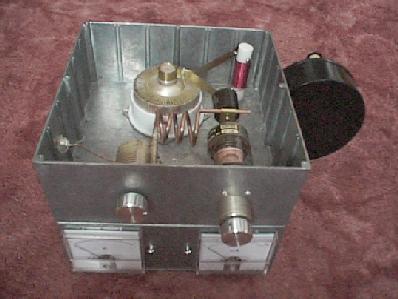 Here is the RF deck, it consists of 2 10" square RS die-cast boxes #
225 271 bolted back to back. they are 4" high. The bottom box contains
the metering circuit, bias relay, heater transformer, bifilar filament
choke, and RF input circuit. The large meters are well screened from RF
and also well decoupled with 1000pf disc ceramics. The lefthand meter is
1 amp for anode current, and the right-hand meter is 100 m/a for grid/cathode
current.
Here is the RF deck, it consists of 2 10" square RS die-cast boxes #
225 271 bolted back to back. they are 4" high. The bottom box contains
the metering circuit, bias relay, heater transformer, bifilar filament
choke, and RF input circuit. The large meters are well screened from RF
and also well decoupled with 1000pf disc ceramics. The lefthand meter is
1 amp for anode current, and the right-hand meter is 100 m/a for grid/cathode
current.
The top box contains the 8877, Anode choke, and Pi-L tank circuit.
Note the strap between the RF choke, the anode head and the 1000pf 20kv
isolating capacitor, this is made from 1/2" wide brass stock, it also forms
the anode connection. The tuning capacitor MUST be a variable vacuum type
and is mounted on the front of the box.
The anode tuning coil is 3 turns of 1/4" copper tubing and is 1
1/4" in diameter as shown above. A high power blower is fitted to the right-hand
side. (see notes below)
The total height of the RF deck is just under 8". On the back bottom
box is the mains input IEC connector (this is fed from the psu), 2 pin
mike skt for the 13.5 volt input, 4 pin mike skt for the B- and Earth returns
and 3 phono/RCA sockets for power to the coaxial relays and PTT line,
2 fuse holders, one for the mains input to protect the filament transformer
and blower, the other one protects the 13.5 relay supply. A PTT switch
was fitted at the side of the LED's, this is not visible in the above photo.
There is also the tuning input capacitor and RF input socket. The lid vent
is meshed with fine strong mesh.
RF DECK UNDERSIDE.
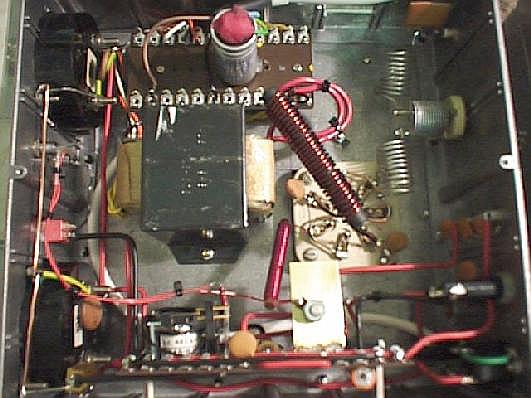 Above you can see the filament transformer near the centre, to the right
is the 8877 base.
Above you can see the filament transformer near the centre, to the right
is the 8877 base.
Top right is the RF input circuit which is a copy of my 3CX800A7
input circuit.
3600pf input from the BNC socket, then coupled to the first coil
which goes to the 100pf tuning capacitor, the second coil fits between
the 100pf cap' and the tubes cathode. All cathode pins on the socket are
shorted together. Pins 1 & 5 are for the big bifilar choke.
Bias board/Zener and cathode choke are at the bottom on a tag board.
The big capacitor at the top of the picture is the motor start capacitor.
The meters are to the left of the picture and are decoupled with 1000pf
4 kv cap's.
Power Supply
PSU Parts Listing.
RS Boxes # 225-271 (2 needed for PSU)
Laminated board to mount Electrolytics RS # 433-523 (1 needed)
Switch/Circuit Breaker RS # 212-2001 (15 amp) RS
Components
3 Minute Timer RS # 349-888 (Must be used) (240vac)
Here
20 Second Timer for in-rush circuit set at 3/4 seconds from RS #
349-872 (240vac)
2 15 ohm 100 watt metal clad power resistors for in-rush circuit.
RS # 188-138
20 amp Mains Relay for in-rush circuit from RS # 245-2431 (240vac)
Here
8 Electrolytics 220mf 450vdc RS # 2280-630 stud mount, or, RS #
116-701 (1.45 amp ripple) 220mf 400vdc clamp mounting. Here
or anything similar will do.
Equalising resistors for electrolytics RS # 199-6148 (47k 12w 8
of) from RS Components
50 ohm 50 watt metal clad resistor (series EHT feed) RS # 160-988
ILP Toroidal HT/Relay Transformer 1.8 kva. AMP
UK 12.5 kilos. Cost 175 UKP
2 15kv PIV 1.2 amp stick rectifiers (
Peter
Dahl ). I also have lots of these which are good for
3CX800 amplifiers as well, try Here
The power supply is also made in two boxes same as
the RF deck, the main transformer, a toroidal, measures 8 1/4" in diameter
and 3 1/4" in height and weighs a mere 25 pounds fits into the bottom box,
the leads are brought into the top box via rubber grommets to stop any
chaffing to the leads, a sheet of 11 thou PTFE 9" in diameter was cut to
double insulate the transformer, WARNING!
Countersink ALL the holes in the bottom box, ie: the ones used to
mount the diodes and any other components, otherwise the screw heads may
damage the transformer! all the other circuitry fits into the top
box, this makes the 2.6kv (on load) power supply extremely compact and
serviceable.
TOP VIEW.
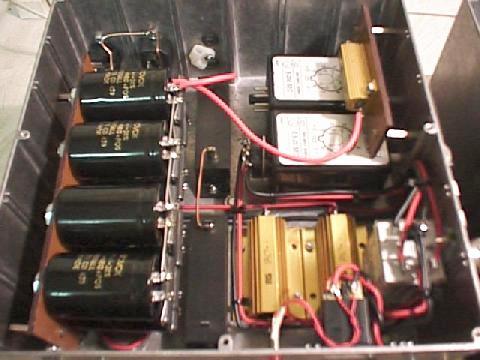 The power supply: As can be seen in the picture the EHT capacitor stack
is mounted on a board on the left-hand side, these electrolytics have bolt
mountings, DO NOT mount them on to any metal
surface as the bolt is also the negative connection! I mounted them on
a small piece of insulation board and then used 6ba standoffs to isolate
the board from the chassis, the 2 main 15kv diodes are to the right of
the EHT capacitors, DON'T use strings of diodes in place of these units
as they are a poor substitute unless shunt capacitors and transient resisitors
are also fitted across each diode, plus, if one or two diodes go short
in any of the legs you should really change the whole lot!, the 2 in-rush
15 ohm 100 watt resistors are further to the right and the relay (20 amp
rated) is placed on the right-hand internal wall, the in-rush circuit is
controlled by a short 4 second RS timer.
The power supply: As can be seen in the picture the EHT capacitor stack
is mounted on a board on the left-hand side, these electrolytics have bolt
mountings, DO NOT mount them on to any metal
surface as the bolt is also the negative connection! I mounted them on
a small piece of insulation board and then used 6ba standoffs to isolate
the board from the chassis, the 2 main 15kv diodes are to the right of
the EHT capacitors, DON'T use strings of diodes in place of these units
as they are a poor substitute unless shunt capacitors and transient resisitors
are also fitted across each diode, plus, if one or two diodes go short
in any of the legs you should really change the whole lot!, the 2 in-rush
15 ohm 100 watt resistors are further to the right and the relay (20 amp
rated) is placed on the right-hand internal wall, the in-rush circuit is
controlled by a short 4 second RS timer.
The 2 timers are installed at the rear right. (one not shown connected
when the picture was taken).
The B-, Earth and 13.5 vac are taken out of the PSU to the RF deck,
2 and 4 pin screw type microphone connectors are used to secure the
connections on the RF deck.
The bottom box houses the main toroidal transformer which provides
the EHT and 13.5 volts for the bias/RF relays on the RF deck. The 13.5
volt supply is controlled by the 180 second timer to ensure it is NOT
possible for the RF deck to go into TX until it's cycle is completed. The
DC components for the 13.5 volt supply are placed in the bottom of the
RF deck along with the heater transformer and bias components, they all
are fitted on a tag board and isolated from the chassis using standoff
pillars.
UNDERSIDE VIEW.
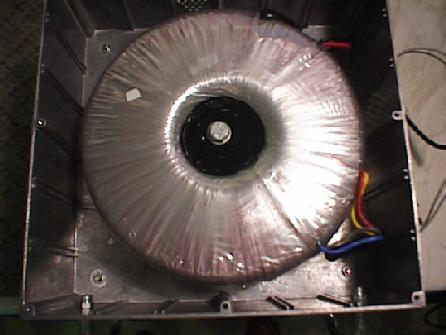 The massive toroidal transformer in the bottom box mounted on a sheet
of PTFE, also note that the leads are fed through the chassis with rubber
grommets. Countersink all holes that are drilled
in the bottom box to stop damage to the transformer!
The massive toroidal transformer in the bottom box mounted on a sheet
of PTFE, also note that the leads are fed through the chassis with rubber
grommets. Countersink all holes that are drilled
in the bottom box to stop damage to the transformer!
This transformer is 8 1/2" in diameter and 3 1/2" high, it weighs
12.5 kilos! and is mounted by one center bolt.
POWER SUPPLY CIRCUIT.
 The above voltage doubler circuit is really the same as for a 3CX800
amplifier, the only difference is that the transformer is "beefed" up and
the Zener diode is a 12 volt 50 or 75 watt version (isolated from chassis).
Use 15kv 1.2 amp diodes (2 of) and not strings of el cheapo diodes in the
doubler circuit, it makes sense, as, unless you include shunt capacitors
(to eliminate any white noise) and transient resistors across each diode
they WILL eventually blow, this will usually happen when dx is on the band!
The above voltage doubler circuit is really the same as for a 3CX800
amplifier, the only difference is that the transformer is "beefed" up and
the Zener diode is a 12 volt 50 or 75 watt version (isolated from chassis).
Use 15kv 1.2 amp diodes (2 of) and not strings of el cheapo diodes in the
doubler circuit, it makes sense, as, unless you include shunt capacitors
(to eliminate any white noise) and transient resistors across each diode
they WILL eventually blow, this will usually happen when dx is on the band!
Also please note that 2 timers are used in the primary circuit,
one controls the in-rush circuit and the other, a 3 minute timer, controls
the 13 volt relay supply.
SLOW START CIRCUIT
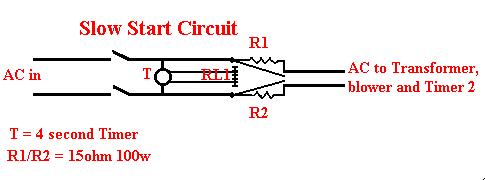 The above slow/soft start circuit is controlled by an RS timer module,
after 4 seconds the power resistors are shorted out by RL1 which is a 20
amp mains operated relay, power is then taken to T2 a 180 second timer
and blower/filament/eht etc.
The above slow/soft start circuit is controlled by an RS timer module,
after 4 seconds the power resistors are shorted out by RL1 which is a 20
amp mains operated relay, power is then taken to T2 a 180 second timer
and blower/filament/eht etc.
A word of warning here! Eimac recommend
3 minute pre-heating on 8877's and 3CX800's, YOU
MUST use a 3 minute timer to prevent damage to these expensive tubes!
* indicates that there is a balancing/bleeder resistor across each
electrolytic capacitor the value being 47K at 12 watt.
The anode meter is 1 amp rated, the grid meter is 100 m/a rated,
there are 2 1N4007 or BY127 diodes across the meters to protect them.
The EHT positive line has a 50 ohm 50 watt metal clad resistor in
line in case of any arcs, this method is preferred to a fuse, don't use
fuses in the eht supply as all they will do if there is a problem is explode!
Make sure that this resistor is isolated from the chassis. (this can be
seen in the top view of the power supply, top right-hand corner).
OPERATING/SETTING
UP DATA.
Before applying any power to the RF unit grid dip the input and output
circuits with a GDO or Spectrum Analyser/sweep generator for return loss
with the tube inserted, make sure that you connect a 50 ohm dummy load
to the input and output connectors if you use a GDO when you do this. This
should at least give you an idea if the circuits are resonant.
Double and triple check the bias/relay wiring, remove the tube and
apply the filament volts, they should be 5v AC +/- 5% to preserve tube
life, only use a digital meter for this measurement as analogue meters
are not accurate enough, if all is ok then switch off and insert the tube.
Before running the amplifier I suggest you
leave the blower and filaments on for 10 hours to burn in the tube for
longer life.
The toroidal transformer I used has 2 500v AC secondary windings,
to set up the amplifier I first of all used only one of the windings into
the voltage doubler, this produced around 1.4kv off load which is ideal
for testing purposes. (the other winding would be added in series later!)
Switch on the power supply, the blower will start along with the
filament voltage present, after 4 seconds the slow start circuit will switch
in and bypass the 2 100 watt metal clad resistors (a clunk as the relay
changes over), you now have to wait for the 180 second timer to complete
it's cycle, when the cycle is complete short the ptt line to chassis, this
should show standing current on the Anode Meter of around 50 m/a due to
the low HT.
OPERATING CONDITIONS
ANODE VOLTS. ANODE CURRENT. GRID CURRENT.
DRIVE. POWER OUT.
1400Vdc
50 M/A
0
0 0
1300Vdc
600 M/A (50 M/A) 40 M/A
20 W 400 W * 13DB
2800Vdc
80 M/A
0
0 0
2600Vdc
700 M/A (80 M/A) 20 M/A
32 W 1000 W *
2600Vdc
800 M/A (80 M/A) 20 M/A
40 W 1200 W * 14.5DB
2600Vdc
900 M/A (80 M/A) 25 M/A
50 W 1500 W * 14.5DB
Note: Grid current is reduced at higher plate potential:
* Measured on Bird 43 on input and output into Bird 1 kw load. Input
VSWR was very low 1.2/1. All capacitors in the input and output
cicuits were half meshed, no adjustments were needed to any of the input/out
coils. (the first time ever I have built an amplifier that never needed
any adjustments!)
The KW
 Sorry the picture is out of focus, but it was a little hard to key the
FT920 and take the shot at the same time! This shot was taken at around
the 700 M/A level (1kw out).
Sorry the picture is out of focus, but it was a little hard to key the
FT920 and take the shot at the same time! This shot was taken at around
the 700 M/A level (1kw out).
ADDITIONAL NOTES
If you intend to run this amplifier above the 1.5Kw level I would suggest
the following.
Replace the loading capacitor with a 300pf variable vacuum type.
Use a vacuum antenna changeover relay, or sequential switch lower
power relays.
Fit a grid over-current trip circuit.
Cooling Notes.
I used a capacitor start single phase 2800/3300 rpm blower, it is 7
1/2" in diameter and is rated about 200 cfm, it is noisey and is far beyond
the requirements of the 8877. The blower is 240 volt AC but on receive
can be run at 110v AC by tapping off the filament transformer via a small
relay if you wish, this eliminates much of the noise on receive.
Blowers are available Here
at Surplus Sales in Nebraska.
 Another completed view of the RF deck and Power supply shown in the
"TX" position.
Another completed view of the RF deck and Power supply shown in the
"TX" position.
Output Ventilation
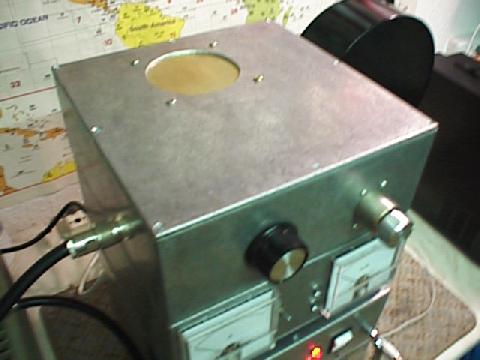 Here is the top view showing the lid meshed with high quality Brass
mesh, the mesh is supported by a square of double sided PCB that is bolted
to the lid and then the hole is cut out of it. Halfords in the UK stock
a DIY Aluminium mesh for car repairs, this is ideal for the above.
Here is the top view showing the lid meshed with high quality Brass
mesh, the mesh is supported by a square of double sided PCB that is bolted
to the lid and then the hole is cut out of it. Halfords in the UK stock
a DIY Aluminium mesh for car repairs, this is ideal for the above.
Input Circuit
 Here is a close up of the cathode tuned circuit, the BNC on the left
back wall feeds the input matching 3600pf capacitor, this in turn is connected
to the 100pf tuning capacitor via L1, L2 is fitted between the tuning capacitor
and the Tube base cathode connection. Note the 2 decoupling capacitors
on pins 1 and 5, these are for the filaments.
Here is a close up of the cathode tuned circuit, the BNC on the left
back wall feeds the input matching 3600pf capacitor, this in turn is connected
to the 100pf tuning capacitor via L1, L2 is fitted between the tuning capacitor
and the Tube base cathode connection. Note the 2 decoupling capacitors
on pins 1 and 5, these are for the filaments.
Anode RFC and EHT Connector
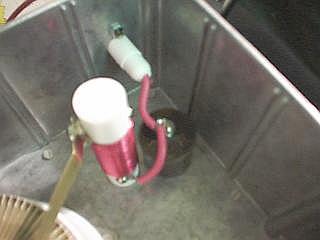 Here is the anode RF choke with 1000pf 20kv doorknob. The psu also has
the same decoupling capacitor installed in it. The EHT connector
was from Surplus Sales in Nebraska.
Here is the anode RF choke with 1000pf 20kv doorknob. The psu also has
the same decoupling capacitor installed in it. The EHT connector
was from Surplus Sales in Nebraska.
Tube and Anode Tuned circuit
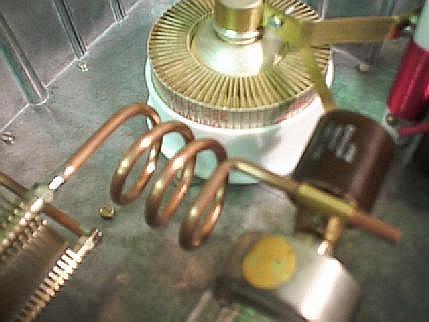 Close up of the Tube, Anode variable vacuum capacitor, 1000pf 20 kv
isolating capacitor, anode tuned circuit, and loading capacitor. The anode
coil is tapped 4 ba to screw onto the loading capacitor bolt, it is then
Silver soldered.
Close up of the Tube, Anode variable vacuum capacitor, 1000pf 20 kv
isolating capacitor, anode tuned circuit, and loading capacitor. The anode
coil is tapped 4 ba to screw onto the loading capacitor bolt, it is then
Silver soldered.
Another Top View
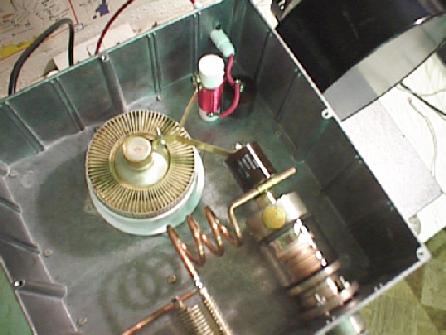 Another view of the plate compartment showing all the circuitry involved
and how very simple it is to build. Not viewable on the left is the "N"
type output socket, this has the Z50 choke across it to chassis to prevent
the HT reaching the antenna if the main blocking capacitor goes short circuit.
Another view of the plate compartment showing all the circuitry involved
and how very simple it is to build. Not viewable on the left is the "N"
type output socket, this has the Z50 choke across it to chassis to prevent
the HT reaching the antenna if the main blocking capacitor goes short circuit.
(Print these pages out for a better view!)
ANALYSER SHOTS.
It is difficult to get good shots with a digital camera due to lighting
conditions, Centre frequency is 100MHz, Horizontal 20MHz per division,
Vertical 10db, this is a sweep of the amplifier which is clean at -60 db+.
Power output is 1kw
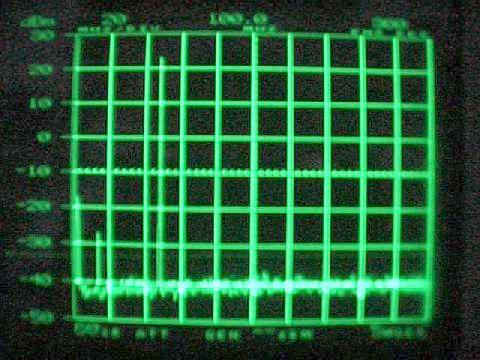 The amplifier and power supply have been given an independent check
over by Broadcast Engineer Dennis GJ3YHU. The output was found to
be -60db at 150MHz and around - 57/58db at 100MHz.
The amplifier and power supply have been given an independent check
over by Broadcast Engineer Dennis GJ3YHU. The output was found to
be -60db at 150MHz and around - 57/58db at 100MHz.
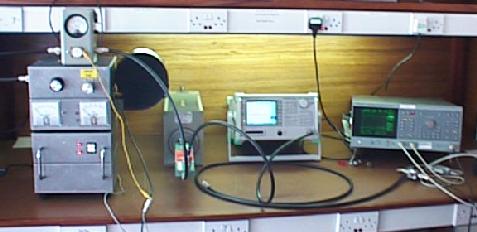 Here's the professional test facility kindly provided by Dennis GJ3YHU,
the unit was tested both "cold" and "hot". The tests proved we had a nice
clean amplifier.
Here's the professional test facility kindly provided by Dennis GJ3YHU,
the unit was tested both "cold" and "hot". The tests proved we had a nice
clean amplifier.
PARTS SUPPLIERS.
Toroidal Transformer. From Amp UK. Here
Beware! it is heavy (13 kilos) and will be VERY costly to transport outside
of the UK. It is purpose designed for 2 3CX800's and also has the 13 volt
3CX800 filament supply.
Variable Vacuum Capacitors from Surplus Sales Try
Here! you can also get the diodes, isolating capacitors (1000pf 20kv)
the bifilar choke, the electrolytic capacitors, filament transformer, the
tube, base and chimney, in fact most of the bits can be obtained from Bob
Grinnell, you can email Bob Here
Send for his brilliant full photo catalogue Here
The main boxes are from RS Components in the UK. They also have
branches around the World, this
is their WWW site, the part # is in the listing.
Please remember, if you are going to buy all new bits then it will
be an expensive project, but still cheaper than buying a new Henry Tempo
3006 at £3,000 plus in the UK!
DISCLAIMER
NO LIABILTY CAN BE PLACED
UPON THE WRITER OF THIS ARTICLE
FOR DEATH OR INJURY SUSTAINED
IN BUILDING THIS PROJECT
THANKS/ACKNOWLEDGEMENTS
Radio Handbook, Bill Orr, W6SAI (slow start circuits for
power amplifiers)
Ham Radio July 1986. (A 6 Meter Kilowatt asmplifier by KX0O)
CQ June 1987. (An Easy to build 8877 for 6 Meters by Steve
Katz WB2WIK)
ARRL Handbook. ( A 3CX800A7 Amplifier for 6 Meters)
Eimac USA. (8877/3CX1500 Operating notes)
Ham Radio Today. (Nov/Dec 1996/Jan 97. A 3CX800A7 Table top
amplifier GJ4ICD)
Dennis Robinson GJ3YHU (for independent sweep of amplifier)
Designed and Built October
1997 Copyright GJ4ICD

 Main
Features include:
Main
Features include:

















